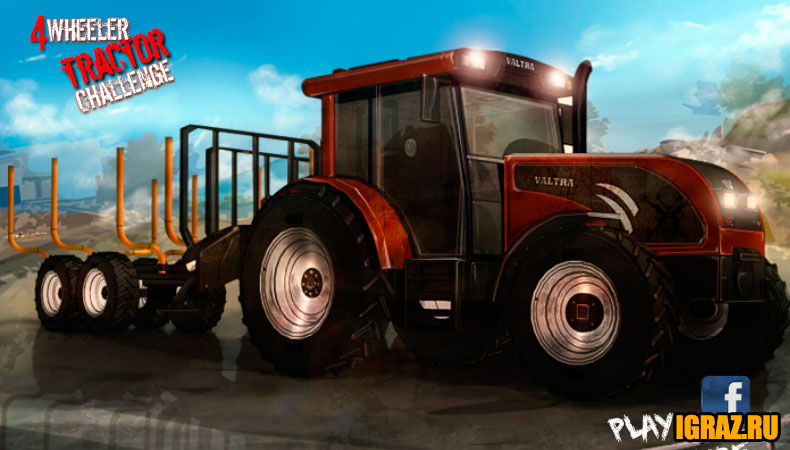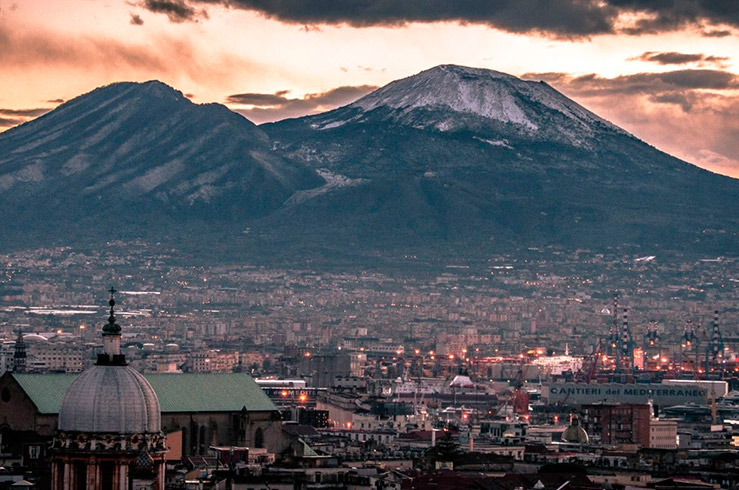The most giant spider on earth. The biggest spider in the world is who he is
To date, the world is home to about forty two thousand species of spiders. The length of the smallest of them, known to science - Patu marplesi - is less than 0.4 millimeters, that is, it is impossible to see it with the naked eye. On the average, the size of these animals usually varies from four to six centimeters. However, in nature there are also giant spiders, each species of which is interesting in its own way.
Terafosa Blonda - the biggest spider on Earth
Most arachnologists studying spiders and arachnids agree that the largest body size of all the currently existing species of these animals is the Goliath tarantula, also known as Terafosa Blond. The color of the body of this spider is usually reddish-brown, on the legs there are numerous reddish hairs.
The most giant spider in the world lives in wet bogs and tropical forests of several countries South America: Venezuela, Suriname, Guyana, Brazil. The length of his body is 7-9 centimeters, and the footprint of the largest specimen found reached 28 centimeters.
The bird-bird of this spider is called erroneously. The basis of his nutrition is actually made up of mice, small snakes, lizards, butterflies and beetles. His victim is trapped in ambush, then suddenly jumps on it, using fangs.
The poison of this spider, paralyzing small animals, is in fact not very dangerous for humans, like the bite of an ordinary bee. As a rule, he does not attack people, except when he is forced to defend himself against them.
In the natural environment, the Goliath tarantula lives in burrows that previously belonged to small rodents. In captivity, it is rare, as exporting it from the territory of countries of habitat, as a rule, is prohibited.
Heteropod Maxima - the longest legged of spiders
Goliath aviary can rightly be called the world's largest spider, based on the size of its torso and weight. However, the competition will be a giant spider-hunter, or Heteropod Maxim - the owner of the longest length in the span of the legs. This indicator in an adult male of this species can be 25-30 centimeters!
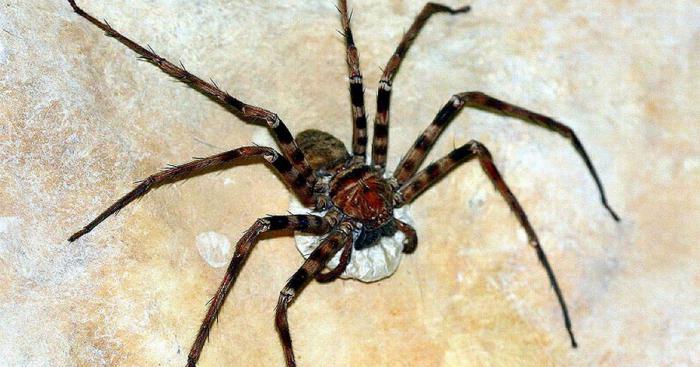
These spiders live mainly on the territory of Laos, preferring deep and dark caves, from which they rarely come to the surface of the earth. Their bodies, relatively small in size (up to 3 centimeters in males and 4.5 in females), are colored brownish-yellow, the abdomen somewhat darker than the cephalothorax.
To date, science knows very little about them, but they continue to be studied.
The record holder of Australia is the giant crab spider
The honor to be called the largest arachnid of the Australian continent belongs to the giant crab spider. Its name is associated with a specific curve of legs, characteristic for crabs (in some specimens their swing sometimes reaches 30 centimeters). In another way, these spiders are called hunters, or huntsmen.

Typically, the color of these creatures - black, brown or gray. The trunk is fluffy, pimples are clearly visible on the legs. They live under the roots and on the trunks of trees, as well as in mountain crevices, between rocks, on the walls of houses. They feed mainly on insects, small lizards and frogs. Their prey, these giant spiders are able to haunt the earth with great speed, before plunging the fangs into it and immobilizing it with the help of poison.
Their toxin is moderately dangerous for humans. As a rule, a painful edema occurs at the site of the bite, sometimes accompanied by nausea and headache, but for the life of a person, the poison does not pose a threat.
Nephil - the most giant spiders in the world, weaving webs
In Latin, the word Nefila means "one who loves to weave." This name is the oldest known species of spiders today. The size of their torso does not strike the imagination - it does not exceed 4 centimeters. But in the reach of the legs, the largest individuals reach 15 centimeters, which makes Nephil the largest spider able to weave a web.

The range of distribution of various types of data spiders is huge. They are found in Australia, South America, Asia and Africa.
The networks that these skilled craftsmen "weave" have truly incredible properties. Exceptionally strong and sticky lace with a characteristic golden tint can cover up to 2 meters. Their fortress is so great that they are able to capture and retain even bat, a small snake or a bird.
The fairly strong poison Nephil spiders are dangerous for people, especially those with a tendency to allergies, but it does not lead to death. Typical symptoms - reddening of the skin, blisters and pain - usually go through the day after the bite.
The Brazilian wanderer is one of the most poisonous spiders
The characteristic features of the Brazilian wandering spider are aggressive behavior and an exceptionally toxic poison. His bite can lead to severe poisoning and paralysis, and in the absence of necessary assistance will lead to the death of a person. That is why the Brazilian wanderers have won unseemly glory, like giant spiders-murderers. However, with the timely provision of the necessary assistance, serious consequences can still be avoided.
These giant spiders (photo below) sometimes reach 10 centimeters in length. The body is elongated, brown, completely covered with small hairs.

Brazilian wanderers do not weave cobwebs and do not have a permanent habitat - they are always in search of their prey. They are found in the tropics and subtropics of South America. They are also called "armed" (due to a strong poison and powerful mouth appendages) or "banana spiders" (as very often they can stumble among the leaves of banana palms). They hunt at night, mostly on insects. However, they can also cope with some reptiles and birds that exceed them in size.
Arabian arabian - newly discovered giant spider
These giant spiders have become known to scientists relatively recently. Some sources indicate that they were opened in 2004, others indicate that this happened in 2010. The countries where the cairns were found were Jordan and Israel, which led to the peculiarity of the name of this species - "Arabian".
The appearance of spiders of this species is very interesting: their body is painted in a beautiful yellowish or silvery color, and long legs They shimmer in the light with silvery and black shades. In length, the largest specimens of Arabian arabic sometimes reach 8 inches.
Currently, this species of spiders is poorly understood. It is known that the Serbs prefer life to the edges of solonchaks and sand dunes. They are characterized by a nocturnal lifestyle, and activity is associated mainly with the hot season.
Tegenaria wall - record holder for running for short distances
In a different way, the teganaria wall is called a giant house spider. The length of her body is about seven centimeters, and the swing of the legs is about three times that. Not surprisingly, tegenarii among arachnids are considered extremely fast runners for short distances.
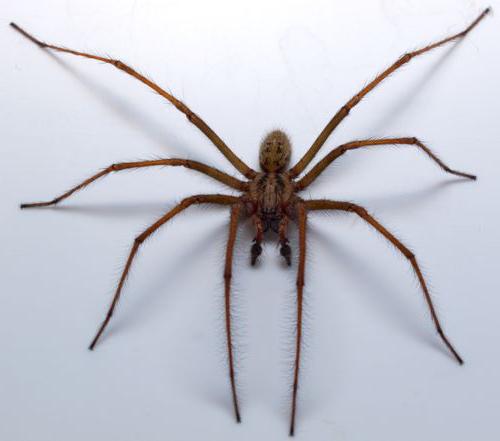
The distribution of this species of spiders is Asia, north of Africa. They are found here and there in some places in Europe (for example, in England, tegenaria is often called a "spider-cardinal" allegedly because the British Cardinal Wolsey once was terrified of it).
It is interesting to note that these giant spiders, although they produce cobwebs, are completely incapable of swaddling prey in cocoon. Instead, they simply release it in a very thick and even layer. It is curious that in the competition for prey Tegenarii comes into conflict with his brothers, often even killing them. Among these spiders, cannibalism is also common.
The favorite places of the Tengenarians are caves and walls abandoned houses. Today there are very few of these spiders in nature.
South Russian tarantula - the largest spider in Russia
Mizgir, or tarantula South Russian, a typical representative of the family of spiders, wolves. The body dimensions of the female of this spider reach three centimeters (the body of the male is slightly shorter). The range of its legs, however, is quite large - 10-11 centimeters. It is distributed not only on territory of Russia, but also in Central Asia.

For mizgiry are characterized by shallow mink in the sand or in the earth, which this spider breaks itself and lining the inside with a web. In them he spends a bright time of the day, at night he can get out on the hunt for the surface. Perfectly sensing vibrations, Mizgir feels when a small insect approaches his shelter. By allowing the prey to close range, the spider immediately rushes at it and kills. In winter, it deepens the mink, and the entrance to it is flooded with earth.
This tarantula practically does not bite people. In the event that the bite occurs, the pain and its consequences are comparable to the bite of a hornet.
Japanese spider crab is the largest arthropod on the planet
In fact, marine spiders do not connect with arachnids. This is a special class of arthropods, numbering more than a thousand species. And the largest of them is a giant sea spider, living near the coast of the Pacific Ocean near Japan, at various depths. The size of the trunk of the largest representatives of this species exceeds 30 centimeters, the scale of the claws is really huge - it can reach 270 centimeters in length! The weight of this arthropod can be twenty kilograms.
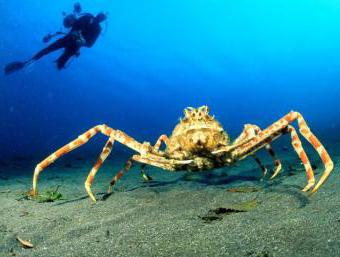
The spider crab feeds mainly on mollusks, and also on the remains of dead animals. There is an assumption that he is able to live about a hundred years.
May 23, 2014, at 18: 55
The biggest spiders in the world
We sometimes do not even think about what huge spiders we have to live in close proximity! In this article we will talk about the largest spider in the world.
12. White lady - the twelfth largest spider on the planet, which was recently discovered by Israeli scientists - in 2009.

The length of the legs of this arthropod, dwelling underground, is almost 14 cm. It hunts quite simply - jumping on its prey. Beware of strolling through the sand dunes of Israel at night - this is the time and place in which the white lady goes hunting!
11. The Brazilian spider-runner has a length of the feet almost 15 cm and has the most dangerous poison!
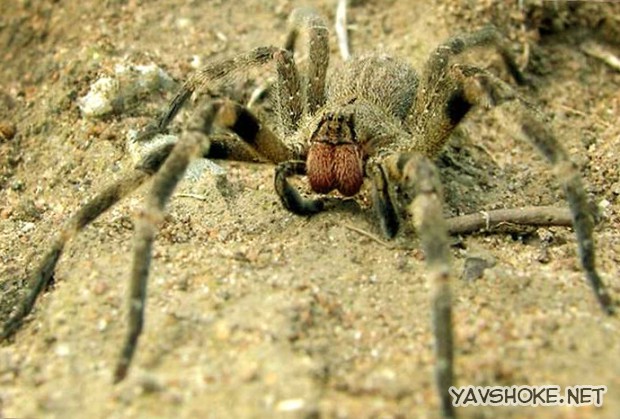
This insect rarely attacks a person, but if this happens, the victim dies in torment. It lives not only in Brazil, but also in the US.
10. Spider - phalanx is surrounded by myths and legends!

Some believe that this arthropod attacked camels and humans, although this, of course, is fiction! The phalanx takes an intermediate place between scorpions and looks similarly to both, and to others. The length of his body is 15 cm.
9. Hercules - tarantula - the rarest on Earth.
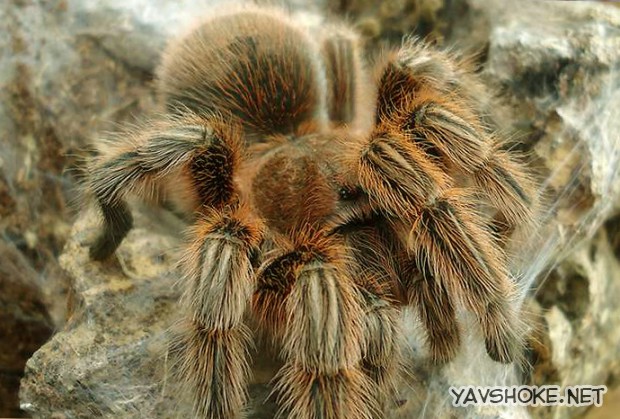
The length of its legs is close to 20 cm, but do not be scared. Since 1900, no one ever met Hercules!
8. Colombian giant black tarantula has legs almost 23 cm long!
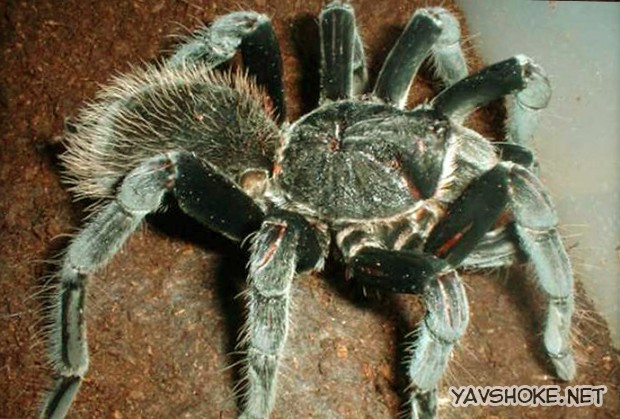
The black body has brown hairs and red spots. The insect is extremely aggressive, but not dangerous for humans.
7. Heteropoda maxima - the range of limbs can reach more than 25 cm.

6. Another among the largest in the world is the Brazilian giant red tarantula living in Brazil, Uruguay, Paraguay and Argentina.

The length of its legs reaches 27 cm, but this does not prevent people from starting this giant at home in the bank, feeding him and taking care of him. This tarantula is interesting because its female, unlike representatives of other species, cares for its offspring and even helps the young to hatch from the egg.
5. Terafosa Blond - the range of his limbs to 28 centimeters.
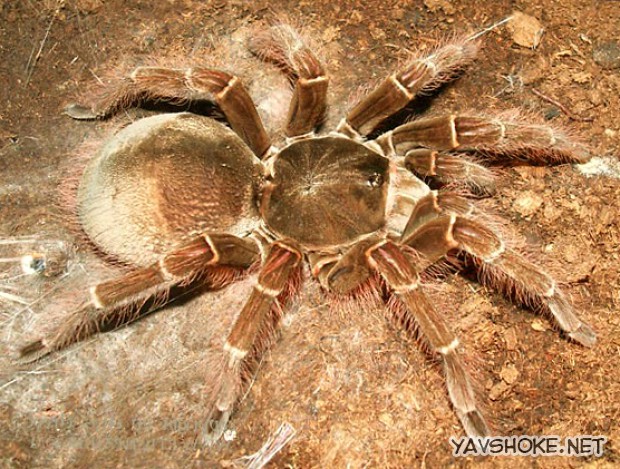
4. The bird-bird inhabiting Sri Lanka was discovered in 2009.

On his belly is a gray-pink strip, on which he is easily distinguishable from others. Poultry lovers like to live in fallen trees, in rocks and human houses!
3. Brazilian pink tarantula does not really feed on birds.

He hunts insects, lizards, frogs and mice. Dwells in the rainforest and has a brown color with patches of pink hairs, which he shoots at the victim, immobilizing it.
2. Spider-hunter has impressive dimensions!

In length, this insect can reach up to 30 cm. Mostly inhabits the territory of Asia, but it was also found in the tropical forests of Florida, Texas and California. In the US, these insects were brought along with bananas, which the spider likes very much! These insects run very fast and can move along vertical smooth surfaces, for example, window panes.
1. The most big spider in the world - tarantula-Goliath.

In the diet of this insect must include birds. With a body length of about 30 cm, the spider has the same legs! This tarantula shoots its hairs into any object that poses a danger to it.
The bite of a goliath is extremely painful, but it is not dangerous to humans. Dwells in the tropical forests of South America, but many are breeding these arthropods as pets. Goliath makes a hissing sound, rubbing one leg on the other, so you can find out about its approach for 4 - 5 meters.
Spider kingdom is diverse and numerous. In our homes, we usually see small six-fingered arachnids, who weave their nets in corners and in other shady places. For a long time, they may remain unnoticed. But in the world of spiders there are also real giants, the scope of whose paws is surprising, and some even inspire fear. We suggest that you consider the TOP-10 of the largest representatives of the spider kingdom and find out what it looks like and what size it has the largest spider in the world.
Spider-shaped amazing creatures and the largest of them can prove to be quite a safe creature! Or not?..
Nephila is a genus of large spiders that weave the largest and most durable cobwebs in which very large prey can be found. For example, in Australia, small birds were found in the networks of the Nephil.
It is interesting! Their hunting networks are so large and strong that they are used even by fishermen engaged in fishing in the waters of the Pacific and Indian Oceans - they collect spiderwebs, roll a ball out of it and lower it into the water. It turns out that this network helps to get a pretty good catch!
Representatives of the genus Nephilic spirits have many names, among the best known are banana spiders and giant tree spiders. Their poison is strong, but it does not represent any serious threat to human health. In most cases, the effects of the bite are local in nature: the affected area slightly reddens, starts to ache, blisters may appear. During the day, these symptoms usually disappear. The development of an allergic reaction and bronchial spasm in patients with asthma is a rarity.
 In nephill crocodile squires rather powerful oral appendages - chelicera, and therefore after a bite on a thin skin there can remain a small scar
In nephill crocodile squires rather powerful oral appendages - chelicera, and therefore after a bite on a thin skin there can remain a small scar
Characteristic:
- body length varies within 1-4 cm;
- the swing of the legs is approximately 12 cm;
- color can be different: from yellow-green to reddish;
- they live on the territory of Australia, Madagascar, America, Asia and Africa.
This specimen belongs to the genus of spiders-runners. In 2010 this rather large arachnid was noted in the Guinness Book of Records as the most poisonous spider in the world. And he is really much more dangerous than the rest of his kind.
The Brazilian wandering spider has won its name quite justifiably. The thing is that he does not sit in his web - they hunt wandering spiders exclusively on foot, during their wanderings. Having noticed the victim, he immediately rushes to it, developing considerable speed. After catching up, he digs into the booty with his chelicera and injects a poisonous secret through the canals of poisonous glands.
The greatest activity manifests itself with the advent of twilight, and in the afternoon prefers to hide in secluded places: sometimes under stones, and sometimes wanders into the dwelling of a man where he hides himself in things and shoes. However, the purposefully Brazilian wandering spider does not attack, but bites solely for the purpose of self-defense.
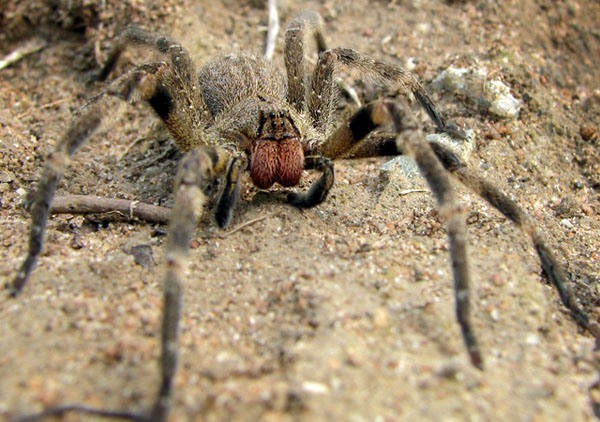 Brazilian wandering spiders like to eat bananas, because of what they got the nickname "banana spiders"
Brazilian wandering spiders like to eat bananas, because of what they got the nickname "banana spiders"
Characteristic:
- body length may be about 5 cm;
- the swing of the legs is about 10-12 cm;
- live in the tropical part of Central and South America;
- the diet includes insects, other spiders, as well as birds and lizards that are larger than himself.
Brachipelm Smith or tarantula Mexican
This is a very attractive tarantula, which is often kept at home (mainly because of its large size and bright color). In the wild, he chooses wet areas, often hiding in dense thickets of shrubs.
On a note! Today, all spiders from the genus Brachypelma are on the list of banned to catch for further sale, as their abundance under natural conditions has dropped dramatically!
Unlike many of the closest "relatives" spider Brahapelm Smith is absolutely non-aggressive. It is considered one of the quietest and its venom is less toxic than other tarantulas. But what is noteworthy, often the poison is not a threat to health, but the burning hairs that cover all of their body and legs. In stress, the spider usually discards part of the hair from the abdomen, and if several villi get on the skin, it is fraught with an allergic reaction - itching and redness. And if the hairs are on the eye mucosa, then serious damage to vision is possible.
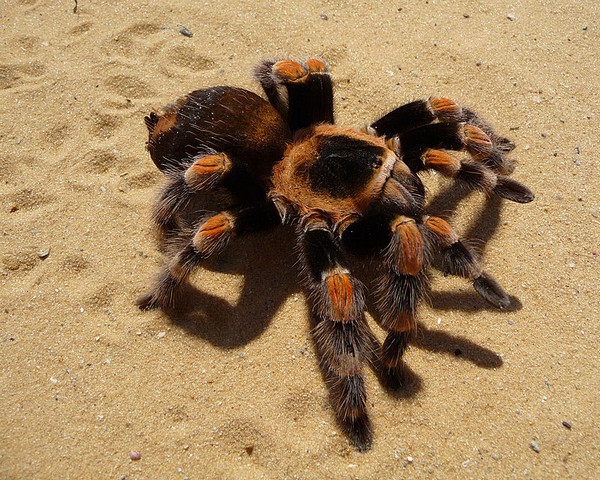 Female Mexican tarantulas live for a long time - about 25-30 years, but at the same time mature they become late - about 2-2.5 years
Female Mexican tarantulas live for a long time - about 25-30 years, but at the same time mature they become late - about 2-2.5 years
Characteristic:
- body size not more than 8 cm;
- the swing of the legs does not exceed 17 cm;
- the body is painted in a dark brown color, in some places the color is black, on the legs there are orange or red fragments, sometimes there may be yellow or white edging;
- the color of hairs covering the body, light pink or brown;
- the diet includes large insects, small lizards and rodents.
Giant baboon spider or royal baboon tarantula
This poisonous giant is also able to become your pet. Giant baboon spider is really quite often kept at home, but, despite the very frightening appearance, it does not represent a particular danger. Its poison, of course, is toxic, but only for small invertebrates. If this spider bites a person, then with the timely provision of medical care, there will be no consequences other than nausea.
Like many other representatives of the spider-world, the baboon tarantula leads a twilight and nocturnal lifestyle. Refers to burrowing species and at the same time its nest is not just a hole, but a whole system of tunnels. Occurs in subtropical and tropical forests. During the hunt, he tears a small groove in the grassy area of the terrain and braids its surface with a cobweb.
Why was this spider called baboon? Because they are very pleased to eat monkeys with a similar name.
It is interesting! Most spiders prefer to lead a solitary lifestyle while cannibalism at an early age is not uncommon in many species. But baboon spiders behave differently - young birds hatched from eggs not only do not eat each other, but even share food. Some adult spiders can co-exist together in one hole and share a system of adjacent tunnels!
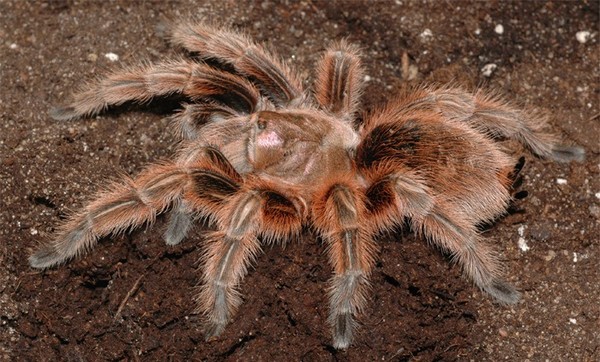 Sensing the danger, the baboon spider lifts the front part of the body and begins to beat the first pair of legs against the ground, while the reproduced sound is very similar to the grinding
Sensing the danger, the baboon spider lifts the front part of the body and begins to beat the first pair of legs against the ground, while the reproduced sound is very similar to the grinding
Characteristic:
- body size reaches 8-9 cm;
- the swing of the legs may be of the order of 20 cm;
- painted in red-brown, like rust color;
- lives on the African continent;
- eats insects, small spiders and small vertebrates.
Colombian violet tarantula
These arthropods are also often planted as eight-legged friends. However, the character of these tarantula spiders is not at all home-they are quite aggressive. Despite this, many still opt for this "sweet" hairy spider, in addition, his bite for a man is absolutely not dangerous.
Colombian violet tarantula its potential victim looks out of a secluded place and when it can be found, then immediately runs out of cover and, catching prey, pierces her body with her powerful chelicera.
 Colombian violet tarantula, eating a victim - a sight not the most pleasant
Colombian violet tarantula, eating a victim - a sight not the most pleasant
Characteristic:
- the swing of the feet reaches 23 cm;
- area: Panama, Ecuador, Colombia, Peru and Venezuela, where it lives in moist rainforests;
- the diet includes insects, small spiders, frogs, fish, small rodents and small birds;
- life expectancy of the female is 15 years, the male is no more than 3 years.
Phalanges
Because of the hump on their back, they are also called camel spiders. They are very mobile and representatives of almost all species are night hunters. Camel spiders on the body and limbs have a rare hairline.
Quite remarkable is their vision. In phalanges, scorpion is the device of the eyes: one pair is located in front and one more eye is at the sides. At the same time, they are all complex, distinguish light and react to movement. And as a result - an excellent response with a minimum delay of a fraction of a second (like a fly). Thus, phalanges are not only excellent hunters, but also practically elusive prey.
Another remarkable feature of the phalanx is their large sturdy chelicera, which can bite not only the skin, but even the human nail. Each chelicera consists of two jointed parts and looks very much like a crab's claw. With their help, spiders cut feathers and wool from the body of their prey, which subsequently cover the bottom of their nest.
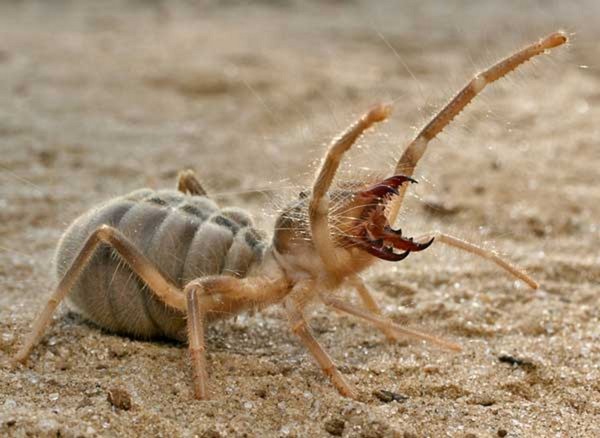 When attacking, the camel's spider begins rubbing its chelicers against each other, creating a piercing chirr
When attacking, the camel's spider begins rubbing its chelicers against each other, creating a piercing chirr
Characteristic:
- body size reaches 7 cm;
- the swing of the legs may be 23-24 cm;
- color yellow-brown;
- it is found everywhere except for the Australian continent, it lives mainly in desert areas;
- feeds on small arthropods, sometimes in the diet there are lizards.
At the sight of this huge spider, the question involuntarily arises, what then should be the biggest spider in the world. And this question is quite understandable, since the size of the spider-hunter is really impressive. The sweep of its paws reaches 25 cm, and the spikes located on them make it look even more frightening. Plus, the legs of this spider are quite unusual shape - curved like a crab. Thus, it is to them that the giant crab spider owes its name.
On a note! The special structure of the legs allows spiders-hunters to easily creep into secluded cracks in wood, under the bark of trees, etc.!
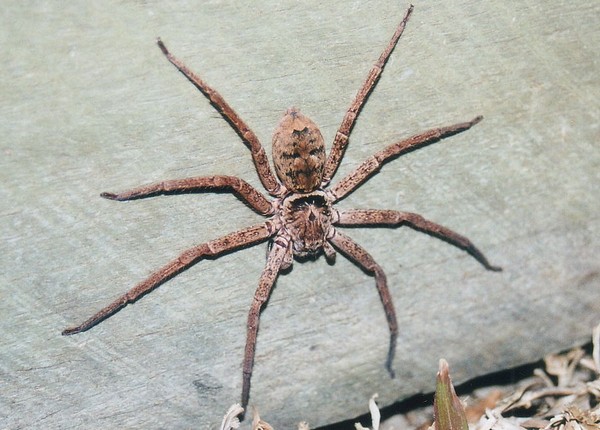 Representatives of this family have one curious feature - females always quite selflessly protect their masonry and newly hatched spiders from enemies
Representatives of this family have one curious feature - females always quite selflessly protect their masonry and newly hatched spiders from enemies
Characteristic:
- body size with legs not more than 25 cm;
- the body is colored gray or light brown in color, in representatives of certain species reddish or black-and-white spots can be observed;
- the thorns are on their feet;
- the trunk is pubescent.
Lasiodora parahybana or Brazilian orange-pink tarantula spider
This species of spider-tarantula was first discovered in 1917. And this spider is endemic, that is its range is very limited, in this case, the state of Paraiba, located in Brazil.
Lasiodora parahybana is one of the largest spiders in the world. The body length of the adult specimen reaches 10 cm, and the range of the legs is 26 cm. The body is colored dark brown or black, which in some places can turn into gray.
Strangely enough, but the main food of these huge spiders are insects, but sometimes in their menu may be larger individuals, such as lizards and mice.
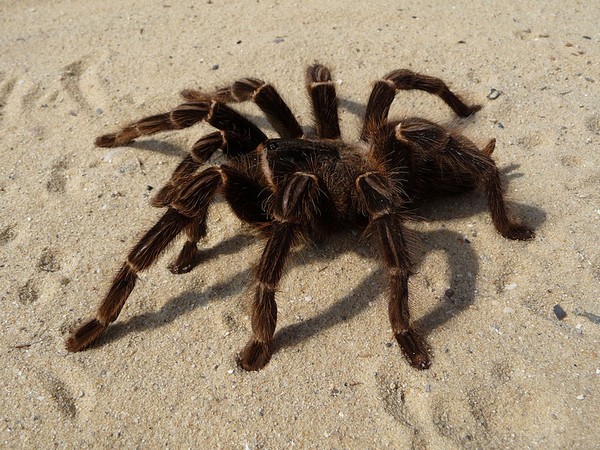 Orange-pink tarantulas, like Mexican tarantulas, dump their burning hairs at risk, which is one of the main mechanisms for their protection
Orange-pink tarantulas, like Mexican tarantulas, dump their burning hairs at risk, which is one of the main mechanisms for their protection The main giant of the spider's world
Do you still want to see the photo of the biggest spider in the world? Then we proceed further.
Goliath Tarantula
It is this representative of the species of tarantulas that is recognized as the largest spider in the world. Goliath-tarantula due to the presence of two-centimeter fangs looks quite frightening. The swing of the paw of an adult specimen reaches about 27-28 cm, and the body weight is about 170 g. It attacks only when it feels threatened. In addition, when bitten, he does not always inject his toxic secret, but even if this happens, it does not pose a particular danger to a person.
Inhabitant goliath-tarantula in the tropics of South America. Housing for himself, he builds himself - pulls out a half-meter mink and covers it with a kind of door from his own web. The life span of females is about 25 years, the males are given much less time by nature - no more than 6 years.
For hunting galiath-tarantula does not use cobwebs. He waits for his victim in a secluded place and at its approach makes a rapid leap. Tarantula digs into the prey with its long chelicera and immediately immobilizes it with poison. And since the spider itself is very large, it is unable to satiate with insects alone. In addition to their diet includes frogs, mice, lizards and even small snakes.
 The goliath tarantula, discovered in 1965, with a swing of 28 cm was included in the Guinness Book of Records as the largest spider on Earth; In 2001, an even larger specimen was found - the span of its paws was 35 cm, but his body was rather small
The goliath tarantula, discovered in 1965, with a swing of 28 cm was included in the Guinness Book of Records as the largest spider on Earth; In 2001, an even larger specimen was found - the span of its paws was 35 cm, but his body was rather small Considering the largest arachnids of the planet, one would also like to mention the largest spider inhabiting Russia. This is the South Russian tarantula: the length of the female body is about 3 cm, the males - no more than 2.5 cm. In comparison with the above-described individuals, it certainly looks rather small.
Preferred for the southern Russian tarantula are the zones with dry climates, so most often it occurs in desert, semi-desert and steppe regions, rarely in the forest-steppe.
For hunting, the South Russian tarantula digs a shallow mink and lays its walls and bottom with its cobweb. When in his field of view there is mining, he immediately jumps out of his hiding place and catches her. As a rule, the signal for attack is the shadow hanging over the mink.
It is interesting! This feature allows you to easily entice the South Russian tarantula from the shelter - just tie a small button to the thread and shake it over the mink!
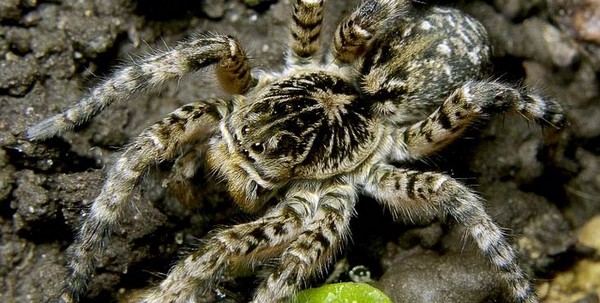 The South Russian tarantula is a night hunter, but far from its nest, it never departs
The South Russian tarantula is a night hunter, but far from its nest, it never departs
The poison of the South Russian tarantula is not of particular concern to humans. At the site of the bite, there is only swelling. Sometimes the skin around the affected area becomes yellow and retains such a shade throughout the month. A person does not cause a poison in a person.
The biggest spider in the world is Terafosa Blond. This spider is able to hunt for toads, mice and even small snakes. The largest spider of this species was found in 1965 in Venezuela and the range of its limbs was 28 centimeters. As for the size of the body, it averages 8-9 cm, and the average span of the spider's limbs is about 25 cm. These giants dwell in the forests of Suriname, Venezuela and northern Brazil. Terafosa Blond was first described by the French entomologist Latreil in 1804.

Another big spider is Heteropoda maxima from the Sparassidae family. Compared to the Terafosa Blonde spider, it has a much smaller body length, which is about 4.5 cm, but the range of the limbs can reach more than 25 cm. Heteropoda maxima is a brownish-yellow spider with irregular dark spots on the head. Also, unlike other spiders, he has not reduced eyes. This species of spider dwells in Laos, Khammaan province.
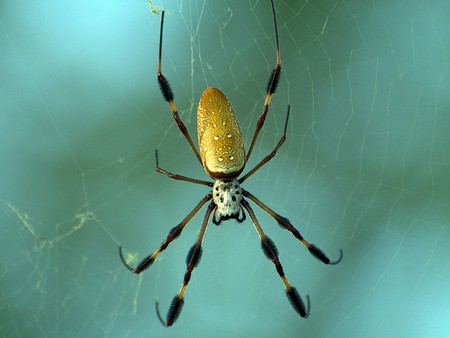
Banana spider is considered to be the largest spider wandering the web. The size of his body does not exceed 4 cm, but the range of limbs reaches 12 cm. In the net, small birds sometimes get to this spider. Even fishermen from the Indian Ocean coast use their net for fishing. For this, they collect many networks, form a large ball of them and throw them into the water. Inhabit the banana spiders in Australia. As for their poison, for humans it is not fatal, although it is considered very strong

This species of spiders belongs to the family of wolf spiders. They dwell in Central Asia, as well as in the south of Russia and Ukraine. The body of the spider is about 3.5 cm in size and densely covered with hairs. They live in burrows, which they dig themselves to a depth of 30-40 cm. They feed, as a rule, by various beetles that run near their burrow. The signal for the attack of a spider is the shadow of an insect, which runs through the entrance to the hole. The South Russian tarantula very rarely bites people, and if the bite happens, it causes a local swelling and strong pain sensations. If the spider bites you, then the place of bite immediately need to burn with a match, because their bites are not very deep and the poison is injected under the skin, and when cauterized, thermal decomposition of the poison occurs.
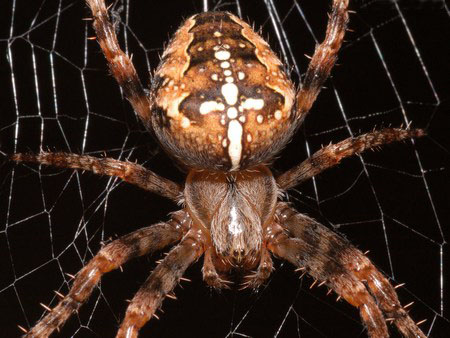
Closes the list of the most large spiders in the world a spider-cross. The crosspiece belongs to the family of spiders of spiders. There are about 1000 species of these spiders, and 30 of them live in the CIS countries. Especially there are a lot of them in the Republic of Altai, Smolensk and Rostov regions, as well as in Moldova. They were named with the crosspieces because of their belly on which there are white spots forming a cross. The size of these spiders is about 2.5 cm, males are half the size of females. Spider's production is flies and mosquitoes caught in the net, which it can immediately eat or swallow with cobwebs, leaving food at a more suitable time. As for the spider's venom, for a person it is completely harmless.
Top 10 very large spiders Video
All known spiders live not only in the wild, but also live in houses and urban apartments. Appearing in the dwelling of a man, some cause fear and horror, others - disgust and disgust. reach a truly grandiose size. Cases when giant spiders grew to 3.5 meters were recorded. And all would be well, if they did not harm a person. In the summer of 2012 in India, several people died from the attack of these monsters. On how to look and what giant spiders-killers eat, this article will be discussed.
The biggest spider
The incredible size of the spider is the crab of Macrocheira kaempferi. Its length with elongated limbs can reach 330 cm. These giant spiders-crabs live in near and Honshu. With such an impressive size, the body is only 60 cm. The main menu of giants: crustaceans, mollusks, small fishes. For people, they do not pose a danger, even on the contrary. Young fish are caught and quite successfully sold to restaurants. Their meat is a valuable delicacy, for which people spend a lot of money. But the old representatives of this species (spider-crab live about 50 years) go to terrariums as exhibition samples. To be afraid of such inhabitants of Pacific ocean it is not necessary, much more terrible and poisonous their terrestrial relatives.
Giant spiders-hunters
The largest specimens belong to the family Sparassidae, in which there are 83 species, one of them is presented in the photo. Giant spiders inhabit the tropical jungle, but often creep into homes and terrify their inhabitants.
 The rainy season forces entire colonies to migrate in search of a suitable home. The size of the spider-hunter is impressive: an adult female reaches 2.5-3 meters. This giant does not need to be confused with the crab, although outwardly they are very similar. Coloring predatory spider - from light gray to dark brown. On the head in two rows are four pairs of eyes, the body is sometimes covered with red spots. The entire body is covered with hair, and the feet are studded. Here already where really a hellish show! Despite their combat, these giant spiders do not attack humans and vertebrates. Their main diet is insects and small invertebrates. Experts argue that these giants bring certain benefits, destroying in large numbers of harmful insects: cockroaches and beetles.
The rainy season forces entire colonies to migrate in search of a suitable home. The size of the spider-hunter is impressive: an adult female reaches 2.5-3 meters. This giant does not need to be confused with the crab, although outwardly they are very similar. Coloring predatory spider - from light gray to dark brown. On the head in two rows are four pairs of eyes, the body is sometimes covered with red spots. The entire body is covered with hair, and the feet are studded. Here already where really a hellish show! Despite their combat, these giant spiders do not attack humans and vertebrates. Their main diet is insects and small invertebrates. Experts argue that these giants bring certain benefits, destroying in large numbers of harmful insects: cockroaches and beetles.
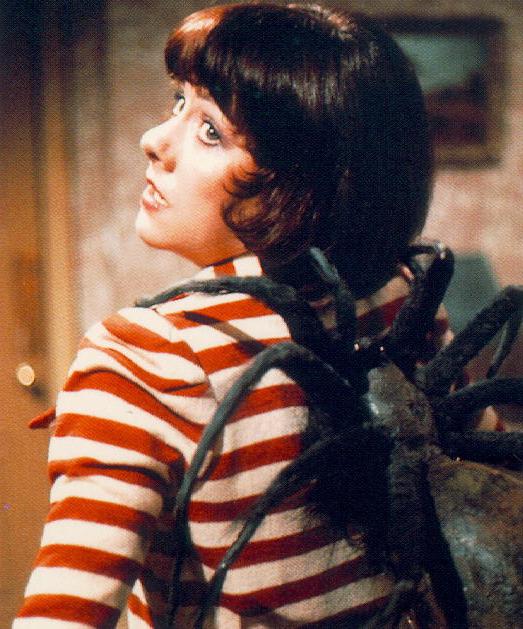
Attacks of predatory spiders in India
The summer of 2012 will be remembered for a long time by the inhabitants of the east of India, the state of Assam. In the city of Sadia, numerous colonies of predatory spiders appeared. Outwardly they looked like a tarantula spider, but the scientists argued about this for a long time. According to eyewitnesses, predators did not just bite a man, but literally attacked civilians. Religious celebrations took place in the central square and unsuspecting people received multiple bites. Two people died, about ten were hospitalized. As the examination showed, the poison of these predators was much more toxic than that of ordinary tarantulas. There are still disputes over the reasons for this behavior of monster spiders.



